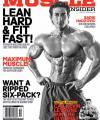Better Muscle Gains with Breakdowns

Get more strength and size gains in a single workout with a research-backed technique called breakdowns. Here we show you how to use it with back training.
I keep reading online trainers who spread the gospel of lightweight training as being superior to (or at least as good as) heavy weights to build maximum muscle. Since I’m most likely found on the other side of the gym, where the heavier weights are located, I thought this odd. Fortunately, someone decided to research the topic.
A 2014 study published in the Journal of Strength and Conditioning Research compared the gains in muscle from a typical bodybuilding-style program to those from one centered on powerlifting.
The subjects weren’t the average college crowd but, rather, gym regulars. In the bodybuilding group, the subjects did 3 sets of 10 reps with a 90-second rest interval; the powerlifting group instead performed 7 sets of 3 reps, resting three minutes between sets. After the eight-week study, the researchers discovered this:
Not surprisingly, the powerlifting group made better gains in strength.
When it came to muscle gain, both groups made near-equal gains.
Although that doesn’t seem to amount to much, the results reaffirm the results of an important Japanese study done a decade earlier. In that study, researchers found that adding a high-rep back-off (lighter weight) set after a heavy 5×5 protocol (5 sets of 5 reps) yielded hypertrophy gains that average 8 percent greater than the group than did the 5×5 alone. In my mind, if you’re not including a back-off set for one or more exercises, you’re likely leaving a significant amount of muscle gains on the table, especially if you’re training heavy. Notably, growth-hormone production increases.
The American researchers concluded, “The results suggest that a combination of high- and low-intensity regimens is effective for optimizing the strength adaptation of muscle in a periodized training program.” Remember, scientifically, high intensity refers to using a weight closer to your single-rep max—that is, heavy weights—whereas low intensity means using more moderate weights.
Fortunately, we don’t have to separate the protocols into different workouts. In fact, my recommendation is to do them both in the same training session! Heavy weights, lighter weights, lower reps, higher reps. We call that breakdowns.
Breaking Down Breakdowns

One of my former mentors, the late Fred Hatfield, PhD, aka Dr. Squat, who founded the International Sports Sciences Association (ISSA) and was a record-holding powerlifter, proposed such an idea years earlier. Before I get into the details, let me unequivocally state it’s one of the most intense and painful protocols I’ve ever tried. That’s not to scare you; rather, it’s an incentive.
It’s pretty simple: The breakdown protocol includes three different rep ranges: low, medium, and high. Not surprisingly, then, you’ll use heavy, medium, and light weights. The sets are performed in reverse-pyramid style, so that after warm-ups you’re doing your heaviest sets first and finishing light. Remember, the “intensity” determines which kinds of muscle fibres are recruited. To target the fast-twitch ones—the ones most prone to growth—you need relatively heavy weights.
Back Training Workout
Let’s take a closer look at how you can use breakdowns when training back. Starting with bent-over rows, after warm-ups your first working set should be done with a heavy weight for 4 to 6 repetitions. That’s a weight you can do for only 4 to 6 reps; if you can do more while maintaining good form, it’s too light. (You may want to complete multiple sets of the heavy or moderate weight, depending on your level of experience.) On the second set, reduce the weight by about 20 percent; you should complete just 10 to 12 reps here. On the third and final set, reduce it by another 20 percent; your goal is now to complete up to 20 reps, but go to muscle failure.
Don’t be afraid to do multiple exercises in your back workout this way. Always start with multi-joint exercises, as you normally would, in reverse-pyramid fashion. Finish with a single-joint movement, such as a straight-arm pull-down or decline-bench dumbbell pull-over (both movements work the lats similarly). Take a bit longer on rest intervals for multi-joint exercises (about three minutes) than for single-joint ones (about 90 seconds).
Ultimately, the research suggests a holistic approach that includes both heavy and light weights may be optimal for bodybuilding gains than training just heavy or light. I’d recommend getting into the habit of doing one back-off set as your last set of every exercise you do.


